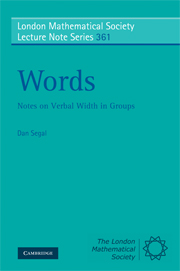5 - Algebraic and analytic groups
Published online by Cambridge University Press: 07 September 2011
Summary
Algebraic groups
Here, algebraic group will mean a Zariski-closed subgroup of SLn (K), for some n ∈ ℕ and some algebraically closed field K. For background and terminology, see [B2], [H2], [PR] and [W1]. In this section, topological language refers to the Zariski topology.
The following theorem, due to Merzljakov, in a sense provides the philosophical background to all the ellipticity results concerning groups of Lie type; a sharper result specific to simple groups is stated below.
Theorem 5.1.1 [M2] Every algebraic group is verbally elliptic.
This depends on Chevalley's concept of constructible sets. Let V = Kd be the affine space, with its Zariski topology. A subset of V is constructible if it is a finite union of sets of the form C ∩ U where C is closed and U is open. A morphism from V to V1 = Kl is a mapping defined by l polynomials.
The key result is
Proposition 5.1.2 Let Y be a constructible subset of V, with closure Ȳ.
(i) (See [W1], 14.9) The set Y contains a subset U that is open and dense in Ȳ.
(ii) (Chevalley, see [H2], §4.4) If f : V → V1 is a morphism then f(Y) is a constructible subset of V1.
- Type
- Chapter
- Information
- WordsNotes on Verbal Width in Groups, pp. 96 - 112Publisher: Cambridge University PressPrint publication year: 2009



